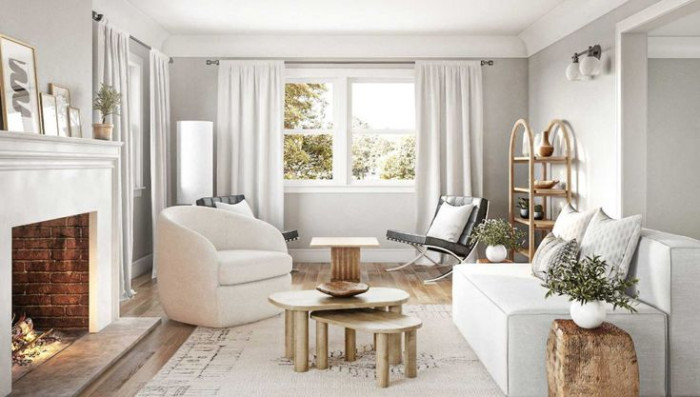Symmetry is a fundamental principle of design. It draws on the natural balance and harmony found in the world around us. From the perfect balance of butterfly wings to the even distribution of petals on a flower, symmetry is a key part of nature’s design that brings a sense of order and tranquillity.
In home décor, symmetry can be a powerful tool to create spaces that are aesthetically pleasing as well as comfortable and inviting.
Understanding Symmetry
Symmetry in design refers to the balanced arrangement of elements on either side of a central axis. There are also several types of symmetry, such as the following three.
Bilateral Symmetry is the most common form. It’s where one side of a space mirrors the other. Think of a pair of identical lamps on either side of a sofa or matching chairs flanking a fireplace.
Radial symmetry is when elements are arranged around a central point. Think about the spokes of a wheel or a round dining table with evenly spaced chairs.
Translational symmetry then involves repeating patterns or elements at regular intervals. Like a row of identical picture frames on a wall.
Each type of symmetry brings a different kind of harmony to a space. But they all serve to create a sense of balance and order.

The Psychological Impact of Symmetry
Symmetry isn’t just visually appealing. It also has a profound impact on our mental wellbeing. Studies have shown that symmetrical environments can reduce stress and promote feelings of relaxation. This is because our brains naturally seek out and appreciate balance and order. In a symmetrical space, the eye can easily navigate and understand the layout, leading to a more comfortable and enjoyable experience.
Practical Tips for Achieving Symmetry in Home Decor
Start with a Focal Point: Every room needs a focal point – a central feature that draws attention and the rest of the room is designed around. In a living room, this might be a fireplace or a large piece of artwork. In a bedroom, it could be the bed. Once you’ve found your focal point, you can create symmetry by arranging furniture and décor elements around it. For example, place identical side tables and lamps on either side of your bed or sofa.
Pair and Repeat Elements: Using pairs of items is a simple yet effective way to introduce symmetry. This can include anything from matching pillows on a sofa to a pair of identical plants flanking a doorway. Repeating patterns or colours across a room also helps to reinforce the sense of balance. For instance, if you have a patterned rug, echo the colours and shapes into your choice of cushions, curtains or artwork.
Balance Asymmetry with Symmetry: While symmetry is essential, too much of it can make a space feel static and uninspired. Balance symmetrical arrangements with a touch of asymmetry to create interest and dynamism. For example, if you have a perfectly symmetrical arrangement on one wall, balance it with an asymmetrical gallery wall on the opposite side. This approach ensures that the room feels balanced but not monotonous.
Symmetry in Furniture Arrangement: Symmetrical furniture arrangements can make a room feel more organised and spacious. In a living room, place sofas and chairs to mirror each other around a central coffee table. In a dining room, ensure that chairs are evenly spaced around the table, For bedrooms, position nightstands and lamps symmetrically on either side of the bed. This not only looks pleasing but also enhances the functionality of the space.
Use Architectural Features: you can use windows, flooring, doors or even built-in shelving as a guide for creating symmetrical décor. For example, if you have a large window in the centre of a wall, place furniture and artwork symmetrically around it. With flooring, it’s not so much about placements, but rather what it adds to the symmetricity of your home; solid wood flooring complements the design due to its uniformity and natural beauty with its straight lines. Whereas parquet flooring can add to the symmetricity with its array of patterns like herringbone and chevron.
Symmetry with Textiles: Think curtains, rugs and cushions, these textiles are excellent tools for introducing symmetry. Choose matching or complementary fabrics and arrange them in a balanced manner. For instance, if you have patterned curtains on one side of the room, you can incorporate the pattern into a matching rug or cushions. Creating a cohesive look than reinforces the sense of symmetry.
Lighting and Accessories: Lighting plays a crucial role in achieving symmetry. Use pairs of lamps, sconces or pendants to create balance. Additionally, accessories like vases, sculptures and picture frames should be arranged in a symmetrical manner. A pair of identical vases on a mantelpiece or matching photo frames on a console table can significantly enhance the symmetry of a room.
The Subtle Art of Imperfect Symmetry
While perfect symmetry is visually striking, incorporating elements of imperfect symmetry can add personality and warmth to a space. This approach involves maintaining a balanced look while introducing slight variations. For example, you might place a tall vase on one side of a mantel and a shorter stack of books on the other. The overall effect is still balanced, but the slight differences add interest and depth.
















